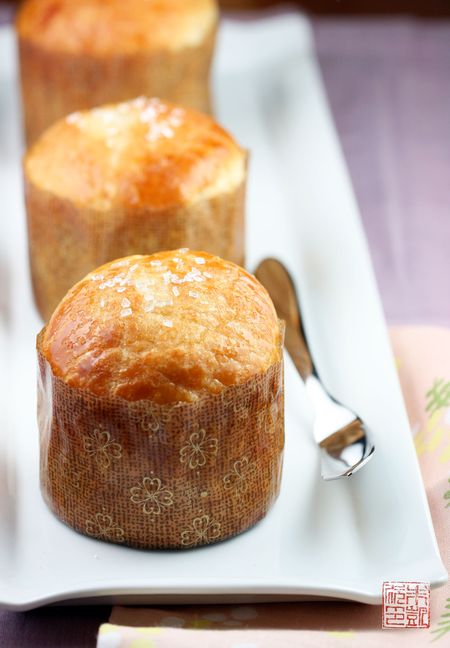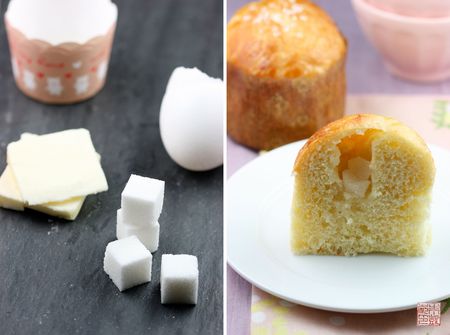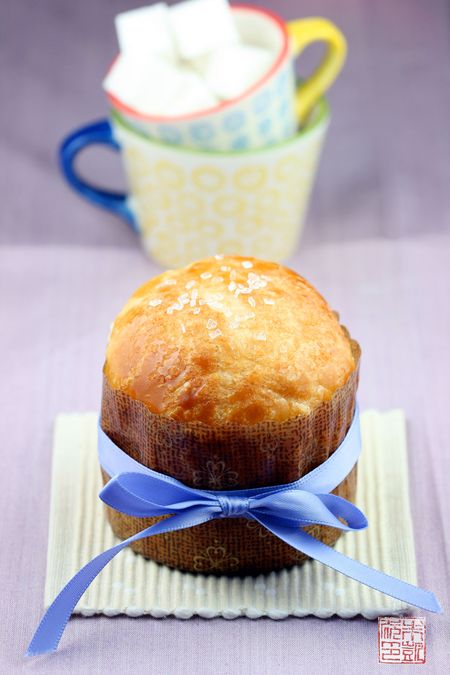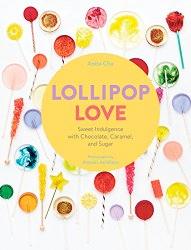edited on 3/21/10: Umm, fangirl moment…Chef Migoya actually saw my post and left a comment! I hope he wasn't turned off by my talk of lactose intolerance earlier! FYI, he also has a blog called The Quenelle – check it out!
Personal reveal here: I've made a unexpected and slightly upsetting discovery recently. I've been noticing that occasionally after meals I've been experiencing indigestion-like symptoms, not strong enough to be incapacitating, but often enough for me to finally wonder if something was amiss.
By slow process of elimination, I finally figured out that it's been milk – especially the milk with my breakfast cereal, that's been the source of the problem. Lactose intolerance? That's my diagnosis so far, although I'm a little surprised, given that I've been consuming dairy almost all my life without ill effect. Can you develop lactose intolerance later in life? I know it's quite widespread among Asians, so I feel fortunate that I had no problem drinking milk in my childhood. In fact, I am nearly certain that my diligent consumption of all the glasses of milk my mother placed before me led to my impressive (for an Asian) growth spurt in my teen years.
(I am aware that 5'4" does not quite qualify as towering, but if you had been back to Hong Kong twenty or so years ago like me, you would seen I was a veritable giantess among my tiny, slim-shouldered cousins. Nowadays, a trip back there and I can easily see the effects of a Westernized diet on the ever-taller youth.)
At any rate, there's no need for concern, readers: I'm not ill in any other way, and taking some lactose-intolerance pills before I eat my breakfast appears to do the trick. I also don't seem to have problems with consuming items that contain dairy, so far, so I count myself lucky in that respect as well.
Very lucky, since I've been making recipes with quite a bit of butter and milk lately. Like these craquelin from The Modern Cafe by Francisco Migoya.
Can you also believe I've never heard of craquelin before now? I've now managed to plug this gap in my pastry knowledge. Craquelin is a unique Belgian version of brioche that contains citrus-scented cubes of sugar tucked into the center of the bun. The sugar cubes melt during baking to create these little pockets of sweetness that burst when bite into the brioche. Brioche's trademark, of course, is it's eggy, buttery, damn-the-artery-clogging richness, but craquelin adds in a zingy sweetness that makes it even easier to inhale. When craquelin cools down, the sugar recrystallizes, adding a crunchy dimension to the bread that I like even more.
Making craquelin is similar to making brioche, with the addition of a few more steps. First, the sugar cubes are mixed with zest to flavor them; I looked some other versions of craquelin and some recipes have Grand Marnier or other liqueur added to the sugar, which I might try next time. Then, the sugar cubes are tucked deep inside balls of brioche dough. Finally, a thin disc of brioche dough is wrapped around the ball, almost like a wrapper, to help keep the bubbling sugar from escaping. Craquelin bakes up just like regular brioche, and the buttery, yeasty scent that fills the kitchen while it's baking is enough to make you want to gobble down the whole batch when it's done.
Francisco Migoya was originally the executive pastry chef at The French Laundry, Bouchon, and Bouchon Bakery, and now teaches at the CIA, so getting The Modern Cafe was a fantastic opportunity to revel in his depth of knowledge. This CIA-published book is a primer on how to run a successful cafe, from tested recipes to tips on presentation, pricing, and packaging. I often get e-mails asking about advice on starting a bakery or baking business, and I'm excited now to have this resource to recommend. Not only are the recipes delicious and unique (you don't want your cafe to offer the same old, same old), they cover all the different parts of a cafe: the bakery (with breads and morning pastries), the pastry shop (with fancy cakes and other desserts), the savory kitchen (with soups, sandwiches, and other simple entrees), beverages (surprising how often people don't think about this high-profit part of a cafe), and retail items (chocolates, jams, and other confections).
In other words, many people think of opening a cafe or coffee shop without thinking of all the various categories they can offer goods to customers, and which ones are the most profitable. It's fascinating to have all this broken down in a book: for example, Migoya explains that the bakery (breads, brioches, muffins, etc) is typically a high-profit area in a cafe because the ingredient costs are relatively low, and the finished products usually don't require refrigeration or other special care. In contrast, the pastry shop can be labor intensive (assembling all those complex cakes), have high ingredient costs (chocolate and other specialty items), and the results are highly perishable. But, well-done pastries can be a major focal point of your cafe and generate good revenue if you manage your costs well.
I'm sure much of this might be old knowledge to veterans in the food industry, however, it's very useful to novices to have this information, along with notes on how long to keep goods on display, professional equipment and techniques, and customer service all presented clearly in an appealingly designed book. The photographs are beautiful, there are tons of useful troubleshooting charts provided, and just a lot of great baking advice. Even if you aren't planning on opening a bakery, I think it's still a wonderful book to have as it covers so much of the fundamentals of pastry.
The book is aimed towards the experienced amateur or professionals: the recipes are presented in metric and US measurements, along with baker's percentages. The instructions are clear although fairly succinct. However, there are typically more in-depth explanations of various baking techniques in each chapter (for example, the brioche recipe takes about a page, but there are about three pages earlier in the chapter that discuss the roles of each ingredient) that should satisfy anyone's culinary curiosity.
Be warned as well: most of the recipes are for larger batches, so you may have to practice your scaling. The craquelin recipe, which uses the base brioche recipe, yielded 40 craquelin, which is entirely too many to have sitting beguilingly about the house. But they were so good, I could almost believe I'd brought them back from some fabulous little bakery-cafe that just opened up down the street.
In the interests of length, and because the brioche recipe in The Modern produces about 8 pounds of dough, I am not reproducing it here. You can use you favorite brioche recipe, or here is one I enjoy from Alice Medrich's Pure Dessert . Double it to get about 20 craquelin
20 sugar cubes
lemon zest from 2 lemons
1 egg for egg wash
sanding sugar
Make brioche according to recipe. Refrigerate until ready to use, up to 24 hours.
Cut the sugar cubes in half and combine with lemon zest in a bowl until uniformly mixed. You can store this mixture at room temperature beforehand to increase the lemon flavor.
Weigh out twenty 2 1/4 ounce pieces of dough and refrigerate. Weigh out twenty 1 ounce pieces of dough and refrigerate.
Shape the 2 1/2 ounces pieces of dough into balls and place back in the refrigerator.
Roll the 1 ounce pieces of dough into 3 inch round discs. If they aren't perfect discs, it's all right – you can stretch the dough out later.
Line a sheet pan with mini panettone cups.
Take out the larger brioche balls. Push 4 sugar cube halves into each ball and roll so the pieces are entirely encased in the dough.
Brush the top of each brioche disc with egg wash. This will make it easier to form it around the brioche balls.
Place a brioche ball in the middle of each disc.
Wrap the discs around the balls, making sure they are completely enclosed with no tears.
Place each craquelin seam side down in a panettone cup. Brush the top of each craquelin with egg wash.
Place the sheet pan inside a plastic bag or cover with plastic wrap. Proof at room temperature (70 to 72 degrees F) until craquelin has risen to the top of the cups. This can take up to three hours – longer if it's colder in your kitchen, shorter if it's warmer. Try placing the craquelin near the warmest spot in your kitchen (not on top of a hot stove, though).
Preheat oven to 390 degrees F.
Brush the top of each craquelin with egg wash again and sprinkle with sanding sugar. Score the center of each craquelin with a pair of scissors, about the size of a dime across and half an inch deep.
Bake for about 12 minutes, until the tops are golden brown. Remove from oven and let cool on a wire rack.





This is a new to me treat too! Sounds wonderful I’ll have to try to make it sometime. I wonder if those sugar cubes are made by splenda yet? ha ha
Yum, looks like a treat and a half! 🙂 About the lactose intolerance thing, I find there are some things that I tend not to digest well – so I never drink milk straight, but it seems to be okay if in custard form, etc.
I developed lactose intolerance later on in life as well. I LOVED milk as a kid and was sad to have to slowly start limiting my milk intake. It really sucks considering all the dairy that goes into desserts, which I am particularly fond of. Definitely an Asian thing.
I am a huge fan of Francisco Migoya.!!! Thanks for this post. Do you his BLOG?..it is awesome <3
http://www.thequenelle.com/
Thanks for such a nice review! Your craquelins look great.
I must say I went through a similar phase a couple years ago… I think around age 25? The giant bowls of cereal with milk in the morning didn’t seem to sit quite right anymore. My husband said the same thing happened to him around the same age!!! I wonder if it is just another transitional phase into adulthood… I mean if you think about it, most mammals are weaned off milk after childhood. I think I read that its actually more “normal” for adults to be lactose IN-tolerant than lactose tolerant!!!! So don’t feel bad. We have switched to the lactose free milk, which tastes JUST the same, and haven’t looked back! Good luck with your new dietary changes!!!!
I’ve never heard of craquelin before but I have Migoya’s book – I’ll have to look for it and also try one of his other tasty creations!
This sounds delicious – I love brioche. About the lactose intolerance, I actually read up on it because my husband is lactose intolerant (Ashkenazi Jews). Apparently you are born with high production of lactase (the enzyme that breaks down lactose), because breast milk has a ton of lactose. As you get older, your body produces less lactase, and in some people, and populations, the production drops precipitously and they become intolerant. Welcome to the club!
Sounds yummy! I had a brioche last week with ‘Nutella’ baked inside of it… you’ll have to give it a try the next time you make another batch of brioche.
wow.. I think this is just perfect for our Saturday tea sessions.. Thanks much for sharing this recipe.. 🙂
I just discovered your blog while searching online for a good pear and almond frangipane tart. Wow! First of all, the tart was AMAZING. I spent a year studying in southern France, and that tart was pretty much a daily purchase. It truly brought me back. Thank you! And secondly, I just wanted to say that your photos and writing are inspiring. I have a custom dessert company that I run out of my home kitchen and I have been considering expansion into a bakery and also going to pastry school to learn the “science” of baking. My desserts would pale in comparison to yours! Hopefully one day I can make it up to your level! Anyway, I love your blog and only wish I had discovered it long ago!
Thank you!!!
Your post could really start a huge discussion.
And your beautiful little cakes could pale besides this stupid issue.
But you can count yourself lucky. that your “just” allergic to lactose.
Did you know that you can find lactic acid in almost in every mustard!?
It’s ridiculous.
About the lactose-intolerance, it normally develops later in life – it would have actually been surprising if you had had it as a child. I wrote a post about it a while back (http://amelieschoice.blogspot.com/2009/08/lactose-intolerance.html).
If your only problem is with straight milk (as opposed to dairy once it is processed in foods), you’re pretty lucky! You should try lactose-free dairy milk, though. There are several brands out there, and you might need to taste a few to find one that you like (in Canada, for example, I dislike Lactaid milk because it has a weird aftertaste, but I love Natrel lactose-free milk because it tastes just the same as regular milk). It is much less of a change than using replacements like soy milk, and I find it easier than having to dose pills to take alongside it. But welcome to the club! 🙂
This recipe sounds so unique! I love the idea. Thanks for sharing the review of The Modern Cafe as well.
It looks perfect, gorgeous!!!
Looks great!
I love your blog! you have desserts that are not easy to find outside, so unique! I can’t wait to try them 😀
WOW i love this post, you have very unique recipes, I can’t wait to try them!
I’m also thinking about opening my own coffee/pastry shop one day…
Hi there, I’m Swedish and in the Nordic countries lactose intolerance is quite common, at least 5% of the population have symtoms of bloated stomachs, and some like me, have atomach aches too. The great thing about so many people in my country being lactose intolerance is the wide range of lactose free products. We have everything! I currently live in the UK and it’s not as well known there, but it’s ok with cheating only occasionally, and I’ve noticed that I can easier digest sour things like creme fraiche and yoghurt than thins with a high fat content, like cream, so try that.
Gentle and freshful thoughts. WOW I like this new articles. I will try this to make it in my future.
These look amazing!
The texture looks so light and fluffy, thanks!
I was very similarly surprised that I’d never heard of craquelin before I picked up Modern Café.
I have yet to try the recipe, but I’m curious about the final product… does the sugar in the center change the flavor of the rest of the brioche, or just add a little sweet crunch to the middle.
Maybe I should just try it myself.
Hi! I discovered your blog a few years ago (I love it) but I seldom have time to do all your wonderful recipes…I’m always postponing everything because of how much I have to study…So why now? I guess I felt the need to share some of my medical knowledge with you (I kind of felt bad for your lactose intolerance, I have it too).
About the lactose intolerance: when we’re born, milk is the only thing we can ingest, and for that purpose our body has tons of lactase (the enzyme that breaks lactose into glucose). This lactase begins to disappear once you grow up. Like animals, we should stop drinking milk, only we don’t. What people don’t know is how frequent this intolerance is. Facts: 90-100% asian are lactose intolerant, as well as, 50-95% native american, 60-85% mediterranean, 85-100% african, 45-80% african american, 10-25% caucasian american. Conclusion: almost the entire world is lactose intolerant. So why do we keep drinking milk? Publicity 🙂
PS- don’t worry about the dairy you use in baking, as long as it’s processed it’s ok 🙂
Those Craquelins look great. I’m making some now (the dough is currently retarding in the fridge) and I hope mine come out close to yours.
I’m using a formula from Eric Kastel’s new “Artisan Breads at Home” (also from the CIA) and it’s pretty similar to Chef Miyagi’s. I hadn’t heard of craquelin until we made them during a class I took at the CIA a few weeks ago, taught by Chef Kastel. I found your blog while looking for other photos to use as references.
I’m in the midst of a career change (I’ve got a non-traditional baking business idea) and your blog has some pretty good advice – I’m trying to find a job at a local bakery so I can learn, and so I can be more sure that I’m thinking about things the right way.
You’ve got a great blog, and are really performing a great service! Thanks! And congratulations on your wedding.
Le Craquelin come from Belgium, you can find it in Wallonie, Bruxelles…
Your recipe is different that the one I have but I am sure all Craquelin recipes ask for belgian pearl sugar in the Plat pays. I know the pearl sugar is not easy to find. I purchase mine in http://www.belgianpearlsugar.com
They imported from Belgium.
Anyway I am going to try your recipe with the belgian pearl sugar and see how it goes. 🙂
Welcome to the club. I too drank milk, galleons of it as a child and young adult. My mother was a terrible cook and I got lots of my calories from milk. When I got married my husband was astonished that I was drinking 2 or 3 large glasses of milk everyday. It was his opinion that milk was for children. I’m not Asian (Russian mother, Jewish father). Sometime in my 30s when I drank milk I got ill, physically ill. So . . . Like others have said, happily milk is fine in cooked dishes.
First your little Craquelins are adorable. I have a suggestion. Years ago when I was cooking from Mastering the Art of French Cooking and making Crepe Suzettes, Julie says to take a sugar cube and rub it against the skin of the orange until the cube is nice and orange. Works great. I can’t see how you get enough flavor from tossing it with the zest? Oh well, guess I should try it before telling you you’re doing it wrong! Sorry.